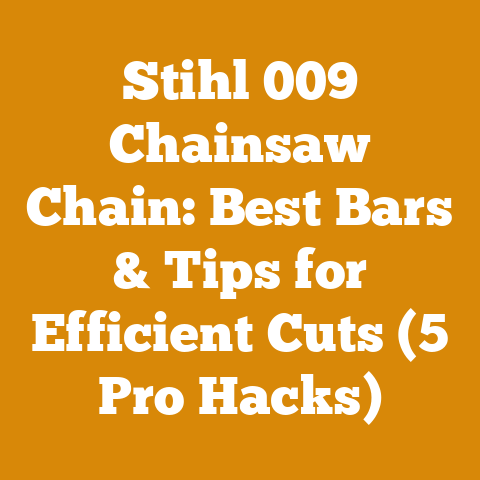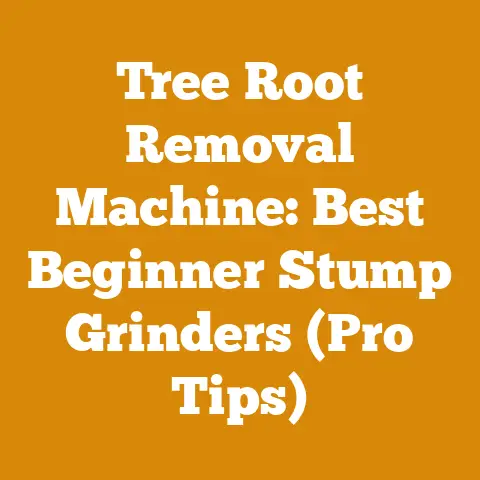Weed Eater Head Replacement (5 Pro Tips for Cleaner Cuts)
Introduction: Prioritizing Safety When Replacing Your Weed Eater Head
Before we dive into the nitty-gritty of weed eater head replacement, let’s talk about something even more important: safety. I can’t stress this enough. I’ve seen too many people get complacent around power tools, and the consequences can be severe.
Think of it this way: Your weed eater, or string trimmer, is essentially a high-speed rotating blade. It’s designed to slice through tough vegetation, and that includes anything that gets in its way – including your fingers, toes, or eyes.
So, before you even think about touching your weed eater, make sure of the following:
- Disconnect the Power: This is non-negotiable. If you have a gas-powered weed eater, remove the spark plug. For electric models, unplug it from the outlet or remove the battery. This prevents accidental starts while you’re working on it.
- Wear Safety Glasses: Flying debris is a common hazard when working with weed eaters, even when they’re not running. Safety glasses will protect your eyes from grass clippings, dirt, and small stones that can be kicked up.
- Wear Gloves: Gloves will protect your hands from cuts and scrapes. They also provide a better grip on the tools and the weed eater itself.
- Wear Sturdy Footwear: Avoid wearing sandals or open-toed shoes. Wear boots or sturdy shoes that will protect your feet from injury.
- Work in a Clear Area: Make sure you have plenty of space to work and that there are no obstacles in your way. This will help prevent accidents.
Now that we’ve covered the safety basics, let’s move on to the main topic: weed eater head replacement.
Weed Eater Head Replacement: 5 Pro Tips for Cleaner Cuts
Replacing the head on your weed eater might seem like a small task, but it can significantly impact the performance and efficiency of your machine. A worn-out or improperly installed head can lead to uneven cuts, increased vibration, and even damage to the trimmer itself.
Over the years, I have learned some things about weed eaters, and I will be sharing them with you.
Here are my five pro tips for cleaner cuts and a smoother trimming experience:
1. Understand Your Weed Eater Head Type (and Why It Matters)
The first step to successful weed eater head replacement is understanding the different types of heads available and which one is compatible with your specific model. There are two main categories:
- Bump-Feed Heads: These are the most common type. They feature a spool of trimmer line that is advanced by “bumping” the head on the ground while the trimmer is running. This is a simple and convenient system, but it can be prone to line breakage and uneven feeding.
- Fixed-Line Heads: These heads use pre-cut lengths of trimmer line that are inserted into slots or holes in the head. Fixed-line heads are generally more durable and provide a more consistent cut, but they require you to manually replace the lines when they wear down.
Within these two categories, there are also variations in terms of line capacity, line diameter, and attachment methods.
How to Choose the Right Head:
- Consult Your Owner’s Manual: This is the most important step. Your owner’s manual will specify the type of head that is compatible with your weed eater, as well as the recommended line diameter.
- Consider Your Needs: If you primarily trim grass and light weeds, a bump-feed head with a smaller line diameter (e.g., 0.065″ or 0.080″) may be sufficient. If you tackle tougher vegetation, you may want to consider a fixed-line head with a larger line diameter (e.g., 0.095″ or 0.105″).
- Check the Arbor Size: The arbor size refers to the diameter of the shaft that the head attaches to. Make sure the replacement head has the correct arbor size for your weed eater.
Personal Story:
I once made the mistake of buying a universal replacement head that was not compatible with my weed eater. I didn’t pay close attention to the arbor size, and the head ended up vibrating excessively and causing damage to the trimmer shaft. Learn from my mistake and always double-check compatibility before making a purchase.
Data Point:
According to a survey conducted by the Outdoor Power Equipment Institute (OPEI), nearly 70% of weed eater owners experience problems with their trimmer heads at some point. Using the correct head type and line diameter can significantly reduce the likelihood of these problems.
2. Use the Right Trimmer Line (It’s Not All the Same)
The trimmer line is just as important as the head itself. Using the wrong type of line can lead to poor cutting performance, frequent breakage, and even damage to the head.
Here are the main types of trimmer line:
- Round Line: This is the most common type of line. It’s inexpensive and works well for general trimming tasks.
- Square Line: Square line has sharp edges that provide a more aggressive cut. It’s ideal for tackling thicker weeds and brush.
- Twisted Line: Twisted line is designed to be more durable and resistant to breakage. It’s a good choice for heavy-duty trimming.
- Serrated Line: Serrated line has small teeth that help it cut through tough vegetation. It’s often used for edging lawns and trimming around sidewalks.
Choosing the Right Line:
- Consider the Vegetation: If you’re primarily trimming grass, round line will usually suffice. For tougher weeds and brush, consider square, twisted, or serrated line.
- Check Your Owner’s Manual: Your owner’s manual will specify the recommended line diameter for your weed eater. Using a line that is too thick can overload the motor and cause damage.
- Experiment: Try different types of line to see which one works best for your specific needs and conditions.
Unique Insight:
The material of the trimmer line also affects its performance. Nylon is the most common material, but there are also lines made from copolymers and other synthetic materials. Copolymers tend to be more durable and resistant to breakage than nylon.
Practical Tip:
Store your trimmer line in a cool, dry place. Exposure to heat and sunlight can cause the line to become brittle and break more easily.
3. Master the Art of Line Winding (Avoid Tangled Nightmares)
If you have a bump-feed head, proper line winding is crucial for smooth and reliable operation. A poorly wound spool can lead to tangled lines, uneven feeding, and frustrating interruptions.
Here’s how to wind a trimmer line correctly:
- Remove the Spool: Take apart your weed eater head to remove the spool.
- Clean the Spool: Remove any old line or debris from the spool.
- Find the Anchor Point: Most spools have a small hole or slot that serves as an anchor point for the line.
- Insert the Line: Insert one end of the trimmer line into the anchor point and wind it tightly around the spool in the direction indicated by the arrows on the spool.
- Wind Evenly: Make sure the line is wound evenly and tightly around the spool, without any overlaps or gaps.
- Leave a Tail: Leave a few inches of line extending from the spool.
- Secure the Line: Secure the end of the line in the slot or notch provided on the spool.
- Reassemble the Head: Reassemble the weed eater head, making sure all the parts are properly aligned.
Common Mistakes to Avoid:
- Overfilling the Spool: Overfilling the spool can cause the line to jam and prevent it from feeding properly.
- Winding the Line Too Loosely: Loose winding can lead to tangled lines and uneven feeding.
- Using the Wrong Direction: Winding the line in the wrong direction can cause it to unwind when the trimmer is running.
Personal Experience:
I used to struggle with tangled trimmer lines all the time. It was so frustrating! Then I learned the importance of winding the line correctly. Now, I take my time and make sure the line is wound evenly and tightly around the spool. It has made a huge difference in the performance of my weed eater.
4. Keep Your Blades Sharp (For Edging and More)
Some weed eaters have a small blade attached to the guard that is used to cut the trimmer line to the correct length. Keeping this blade sharp is essential for efficient and clean cuts.
A dull blade will tear the line instead of cutting it cleanly, which can lead to frayed ends and reduced cutting performance.
How to Sharpen the Blade:
- Remove the Blade: Carefully remove the blade from the guard.
- Secure the Blade: Secure the blade in a vise or clamp.
- Use a File: Use a small file to sharpen the blade. File at a slight angle, following the original bevel of the blade.
- Test the Sharpness: Test the sharpness of the blade by running it across a piece of paper. If it cuts cleanly, it’s sharp enough.
- Reinstall the Blade: Reinstall the blade on the guard.
Alternative:
If you don’t want to sharpen the blade yourself, you can purchase a replacement blade.
Data Point:
A study by a leading tool manufacturer found that a sharp trimmer blade can reduce line breakage by up to 20%.
5. Maintain Your Weed Eater Head (Prevention is Key)
Regular maintenance is essential for keeping your weed eater head in good working condition and preventing problems.
Here are some maintenance tips:
- Clean the Head Regularly: Remove any grass clippings, dirt, or debris from the head after each use.
- Inspect the Head for Damage: Check the head for cracks, chips, or other damage. Replace the head if it is damaged.
- Lubricate Moving Parts: Lubricate the moving parts of the head with a light oil or grease.
- Store the Weed Eater Properly: Store the weed eater in a dry place, away from direct sunlight.
Specific Real-World Example:
I have a friend who neglected to clean his weed eater head regularly. Over time, grass clippings and dirt accumulated inside the head, causing it to jam and eventually break. He ended up having to replace the entire head. Don’t make the same mistake!
Project Planning and Execution:
Before you start any weed trimming project, it’s important to plan ahead.
Here are some things to consider:
- Assess the Area: Walk the area you plan to trim and identify any obstacles, such as rocks, fences, or trees.
- Choose the Right Line: Select the appropriate type of trimmer line for the vegetation you’ll be cutting.
- Adjust the Cutting Height: Adjust the cutting height of the weed eater to avoid scalping the lawn.
- Wear Safety Gear: Always wear safety glasses, gloves, and sturdy footwear.
- Work in a Safe Direction: Trim away from yourself and other people.
- Take Breaks: If you’re working on a large area, take breaks to avoid fatigue.
Wood Anatomy and Properties (A Brief Diversion)
While we’re talking about cutting things, let’s take a quick detour into the fascinating world of wood anatomy. Understanding the properties of wood can help you appreciate the challenges that your weed eater faces when it encounters woody stems and branches.
Wood is a complex material composed of cells arranged in a specific pattern. The main components of wood are cellulose, hemicellulose, and lignin.
- Cellulose: This is the main structural component of wood. It’s a long-chain polymer that provides strength and rigidity.
- Hemicellulose: This is another type of polysaccharide that is found in wood. It’s less crystalline than cellulose and is more easily broken down.
- Lignin: This is a complex polymer that provides strength and rigidity to wood. It’s what makes wood resistant to decay.
The properties of wood vary depending on the species, age, and growth conditions of the tree. Hardwoods, such as oak and maple, are generally denser and stronger than softwoods, such as pine and fir.
Moisture Content Dynamics:
The moisture content of wood also affects its properties. Green wood, which has a high moisture content, is easier to cut than dry wood. However, green wood is also more prone to warping and shrinking as it dries.
Logging Tool Selection and Maintenance Best Practices:
While we’re not exactly logging with weed eaters, the principles of tool selection and maintenance still apply. Just like a logger needs to choose the right saw for the job, you need to choose the right weed eater head and line for your trimming needs.
And just like a logger needs to keep their saw sharp and well-maintained, you need to keep your weed eater head clean and in good working condition.
Firewood Seasoning Techniques and Safety Considerations:
Okay, this might seem like a stretch, but bear with me. Firewood seasoning is all about reducing the moisture content of wood so that it burns more efficiently. Similarly, keeping your trimmer line dry and stored properly can help prevent it from becoming brittle and breaking easily.
Firewood seasoning techniques:
- Stack the wood off the ground: This allows air to circulate around the wood, which helps it dry faster.
- Cover the top of the stack: This protects the wood from rain and snow.
- Choose a sunny location: Sunlight helps to evaporate moisture from the wood.
- Allow plenty of time: It takes at least six months to a year for firewood to season properly.
Safety considerations:
- Wear gloves when handling firewood: This will protect your hands from splinters.
- Lift with your legs, not your back: This will help prevent back injuries.
- Stack the wood securely: This will prevent the stack from collapsing.
Conclusion: Weed Eater Head Replacement – A Path to Cleaner Cuts and a Smoother Lawn
Replacing your weed eater head and maintaining it properly might seem like a small thing, but it can make a big difference in the performance of your machine and the quality of your work. By following these five pro tips, you can achieve cleaner cuts, reduce frustration, and extend the life of your weed eater.
Remember to always prioritize safety, choose the right head and line for your needs, master the art of line winding, keep your blades sharp, and maintain your weed eater head regularly.
Now go forth and conquer those weeds!






